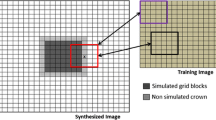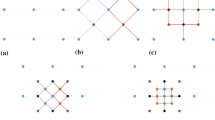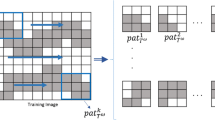Abstract
The advent of multiple-point geostatistics (MPS) gave rise to the integration of complex subsurface geological structures and features into the model by the concept of training images. Initial algorithms generate geologically realistic realizations by using these training images to obtain conditional probabilities needed in a stochastic simulation framework. More recent pattern-based geostatistical algorithms attempt to improve the accuracy of the training image pattern reproduction. In these approaches, the training image is used to construct a pattern database. Consequently, sequential simulation will be carried out by selecting a pattern from the database and pasting it onto the simulation grid. One of the shortcomings of the present algorithms is the lack of a unifying framework for classifying and modeling the patterns from the training image. In this paper, an entirely different approach will be taken toward geostatistical modeling. A novel, principled and unified technique for pattern analysis and generation that ensures computational efficiency and enables a straightforward incorporation of domain knowledge will be presented.
In the developed methodology, patterns scanned from the training image are represented as points in a Cartesian space using multidimensional scaling. The idea behind this mapping is to use distance functions as a tool for analyzing variability between all the patterns in a training image. These distance functions can be tailored to the application at hand. Next, by significantly reducing the dimensionality of the problem and using kernel space mapping, an improved pattern classification algorithm is obtained. This paper discusses the various implementation details to accomplish these ideas. Several examples are presented and a qualitative comparison is made with previous methods. An improved pattern continuity and data-conditioning capability is observed in the generated realizations for both continuous and categorical variables. We show how the proposed methodology is much less sensitive to the user-provided parameters, and at the same time has the potential to reduce computational time significantly.
Similar content being viewed by others
References
Arpat GB (2005) Sequential simulation with patterns. PhD thesis, Stanford University
Arpat BG, Caers J (2007) Stochastic simulation with patterns. Math Geol 39(202):177–203
Borg I, Groenen PJF (1997) Modern multidimensional scaling. Springer, New York
Buja A, Swayne DF, Littman M, Dean N, Hofmann H, Chen L (2008) Data visualization with multidimensional scaling. J Comput Graph Stat 17(2):444–472
Caers J (2008) Distance-based random field models and their applications. In: Proceedings of the eighth international geostatistics congress, Santiago, Chile, vol 1, Plenary
Caers J, Park, KA (2008) Distance-based representation of reservoir uncertainty: the Metric EnKF. In: Proceedings to the 11th European conference on the mathematics of oil recovery, Bergen, Norway
Chiles JP, Delfiner P (1999) Geostatistics: modeling spatial uncertainty. Wiley, New York
Cover TM, Thomas JA (1991) Elements of information theory. Wiley, New York
Cox TF, Cox MAA (2001) Multidimensional scaling. Chapman & Hall, London
Daly C (2004) Higher order models using entropy, Markov random fields and sequential simulation. In: Leuangthong O, Deutsch CV (eds) Geostatistics, Banff 2004. Springer, Dordrecht, pp 215–224
Daly C, Knudby C (2007) Multipoint statistics in reservoir modelling and in computer vision. In: Petroleum Geostatistics 2007. Cascais, Portugal
Deutsch CV, Gringarten E (2000). Accounting for multiple-point continuity in geostatistical modeling. In: 6th International Geostatistics Congress, Geostatistics Association of Southern Africa, vol 1, pp 156–165
Deutsch CV, Wang L (1996). Hierarchical object-based geostatistical modeling of fluvial reservoirs. Paper SPE 36514 presented at the 1996 SPE Annual Technical Conference and Exhibition, Denver, Oct 6–9
Dimitrakopoulos R, Mustapha H, Gloaguen E (2010) High-order statistics of spatial random fields: Exploring spatial cumulants for modelling complex, non-Gaussian and non-linear phenomena. Math Geosci 42(1):65–100
Dujardin B, Wu J, Journel A (2006), Sensitivity analysis on filtersim. In: 19th SCRF affiliate meeting, Stanford University
Gloaguen E, Dimitrakopoulos R (2009) Two-dimensional conditional simulations based on the wavelet decomposition of training images. Math Geosci 41(6):679–701
Goovaerts P (1997) Geostatistics for natural resources evaluation. Oxford University Press, New York
Guardiano F, Srivastava RM (1993) Multivariate, geostatistics: beyond bivariate moments. In: Soares A (ed) Geostatistics Troia. Kluwer Academic, Dordrecht, pp 133–144
Haldorsen HH, Lake LW (1984) A new approach to shale management in field-scale models. Soc Pet Eng J 24(8):447–452
Holden L, Hauge R, Skare O, Skorstad A (1998) Modeling of fluvial reservoirs with object models. Math Geol 30(5):473–496
Honarkhah M, Caers J (2008) Classifying existing and generating new training image patterns in kernel space. In: 21st SCRF affiliate meeting, Stanford University
Honarkhah M, Caers J (2009) Stochastic simulation of patterns using distance-based pattern modeling. In: 22nd SCRF affiliate meeting, Stanford University
Isaaks E (1990) The application of Monte Carlo methods to the analysis of spatially correlated data. PhD thesis, Stanford University
Journel AG (1983) Non-parametric estimation of spatial distributions. Math Geol 15(3):445–468
Kjønsberg H, Kolbjørnsen O (2008) Markov mesh simulations with data conditioning through indicator kriging. In: Proceedings of the Eighth International Geostatistics Congress, Santiago, Chile
Lyster S, Deutsch CV (2008) MPS simulation in a Gibbs sampler algorithm. In: Proceedings of the eighth international geostatistics congress, Santiago, Chile, vol 1, Plenary
MacKay DJC (2003) Information theory, inference, and learning algorithms. Cambridge University Press, Cambridge
MacQueen JB (1967) Some Methods for classification and analysis of multivariate observations. In: Proceedings of 5-th Berkeley symposium on mathematical statistics and probability, Berkeley, University of California Press, vol 1, pp 281–297
Maitre H, Campedel M, Moulines E, Datcu M (2005) Feature selection for satellite image indexing. In: ESA-EUSC: image information mining, Frascati, Italy
Ortiz JM, Deutsch CV (2004) Indicator simulation accounting for multiple-Point statistics. Math Geol 36(5):545–565
Park KA, Schiedt C, Caers J (2008) Simultaneous conditioning of multiple non-Gaussian geostatistical models to highly nonlinear data using distances in kernel space. In: Proceedings of the eighth international geostatistical congress, Santiago, vol 1, Plenary
Parra A, Ortiz JM (2009) Conditional multiple-point simulation with a texture synthesis algorithm. In: IAMG 2009 Conference, Stanford University
Remy N, Boucher A, Wu J (2008) Applied geostatistics with SGeMS: a user’s guide. Cambridge University Press, Cambridge
Russ JC (1995) Image processing handbook, 2nd edn. CRC Press, Boca Raton
Scheidt C, Caers J (2008) Representing spatial uncertainty using distances and kernels. Math Geosci 41(4):397–419
Scheidt C, Caers J (2009) A new method for uncertainty quantification using distances and kernel methods. Application to a deepwater turbidite reservoir. In: SPEJ, SPE-118740-PA
Scholkopf B, Smola AJ (2001) Learning with kernels: support vector machines, regularization, optimization, and beyond. MIT Press, Cambridge
Shannon CE (1948) A mathematical theory of communication. Bell Syst Tech J 27:379–423
Shawe-Taylor J, Cristianini N (2004) Kernel methods for pattern analysis. Cambridge University Press, Cambridge
Srivastava RM (1992) Reservoir characterization with probability field simulation. SPE paper no. 24753
Stoyan D, Kendall WS, Mecke J (1987) Stochastic geometry and its applications. Wiley, New York
Strebelle S (2000) Sequential simulation drawing structures from training images. PhD thesis, Stanford University
Strebelle S (2002) Conditional simulation of complex geological structures using multiple-point geostatistics. Math Geol 34(1):1–22
Suzuki S, Caers J (2006) History matching with an uncertain geological scenario. In: SPE Annual Technical Conference and Exhibition, SPE 102154
Suzuki S, Caers J (2008) A distance-based prior model parameterization for constraining solutions of spatial inverse problems. Math Geosci 40(4):445–469
Suzuki S, Caumon G, Caers J (2008) Dynamic data integration for structural modeling: model screening approach using a distance-based model parameterization. Comput Geosci 12(1):105–119
Tjelmeland H (1996) Stochastic Models in reservoir characterization and Markov random fields for compact objects. Doctoral Dissertation, Norwegian University of Science and Technology. Trondheim, Norway
Tjelmeland H, Eidsvik J (2004) Directional metropolis-Hastings updates for posteriors with non linear likelihood. In: Leuangthong O, Deutsch CV (eds) Geostatistics, Banff. Springer, Dordrecht, pp 95–104
Wu J (2007) 4D seismic and multiple-point pattern data integration using geostatistics. Phd thesis, Stanford University
Zhang T (2006) Filter-based training pattern classification for spatial pattern simulation. PhD thesis, Stanford University, Stanford, CA
Zhu M, Ghodsi A (2006) Automatic dimensionality selection from the scree plot via the use of profile likelihood. Comput Stat Data Anal 51(2):918–930
Author information
Authors and Affiliations
Corresponding author
Rights and permissions
About this article
Cite this article
Honarkhah, M., Caers, J. Stochastic Simulation of Patterns Using Distance-Based Pattern Modeling. Math Geosci 42, 487–517 (2010). https://doi.org/10.1007/s11004-010-9276-7
Received:
Accepted:
Published:
Issue Date:
DOI: https://doi.org/10.1007/s11004-010-9276-7




